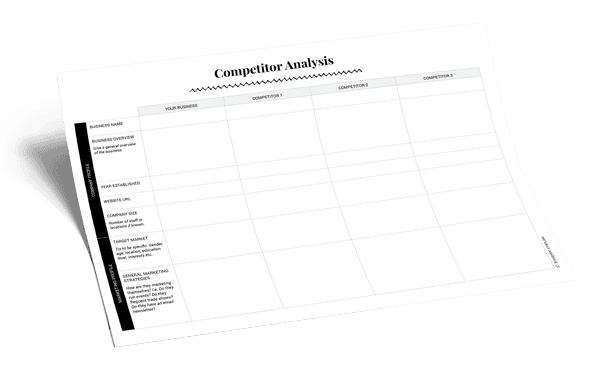How to do a Simple but Effective Competitor Analysis
If you want to be a successful business owner, you need to be keeping a close eye on your competitors.
In marketing, the act of monitoring your competitors is referred to as Competitor Analysis or Competitor Intelligence. And even though you might protest and say that what you do is unique and special. Which were quite sure it is, the simple fact is that there are other businesses out there delivering a similar outcome to you. When people are shopping around for the best person to deliver that outcome. Rest assured they’ll also be checking out your competitors and assessing all their options before deciding to buy. Sure you do your due diligence and shop around before you decide to purchase something, right?
If you want to be a successful business owner, you need to be keeping a close eye on your competitors.
Unless your business marketing and social presence is compelling and instils trust and confidence in your brand. It will be difficult to win business over your competitors.

But that’s not the only reason you should be spying on your competitors.
You should also be doing Competitor Analysis with the intention to find ways to improve your own business strategies, and to elevate your business above the rest.
Plus, Competitor Analysis can give you inspiration and ideas on how to do things better.
And don’t worry, by doing Competitor Analysis you’re not doing anything wrong. On the contrary! Competitor Analysis is an established requirement of all marketing teams in all businesses. It’s completely legal. It’s simply the act of collecting information that is already available in the public domain and using it to better understand your position in the market.
Conducting Competitor Analysis can give you inspiration and ideas on how to do things better. Share on XWhen we first engaged in Competitor Analysis (which we resisted for a long time). We found it strangely empowering and liberating. It helped us to understand how we’re the same, but also different to our competitors. It helped us clearly establish my USP – or Unique Selling Proposition – which made all our branding efforts much more powerful. Your USP is one of the most critical ingredients in your marketing strategy.
You should also be doing Competitor Analysis with the intention to find ways to improve your own business strategies, and to elevate your business above the rest.
There are 9 steps we recommend you follow for a simple but powerful Competitor Analysis. There are all kinds of clever ways to get competitor information online (for example Spyfu, iSpionage, Fanpage Karma etc), but it’s not necessary for a robust Competitor Analysis. Keep it simple to start.
Follow the 9 steps below to spy on your competitors and set yourself up for maximum business success!
How to do a Simple but Effective Competitor Analysis
1. Stay Ahead of Industry Trends & Competitors with Google Alerts
Before we get into the nitty-gritty of Competitor Analysis. The first thing that every business owner needs to do to stay on top of industry trends and announcements is to sign up to Google Alerts. This is a free service offered by Google that notifies you of all publications across the web for keywords that you can specify.
For example, if you’re a Life Coach, you could set up an Alert using the keyword ‘Life Coaching’. Then Google will send you a daily digest of everything that’s published each day that contains that search term.
This is a fantastic (and essential) way to learn what’s happening each day across your industry and to stay on top of what your competitors are doing. These Alerts can also provide great content for your curated posts on social media.
Google Alerts are a fantastic (and essential) way to learn what’s happening each day across your industry and to stay on top of what your competitors are doing. Share on X2. Make a List of Your Top 3-5 Competitors
Set yourself up with a spreadsheet or table with 5-7 columns: 1 column on the left for the headings outlined below. 1 column next to that entitled ‘Your Business’ and then 3-5 vertical columns labelled Competitor #1, Competitor #2 etc. (you’ll have one vertical column per competitor).

Do a simple Google Search using your industry keywords to determine who else is delivering a similar service, in a similar way to you. For example, if you’re a Health Coach specialising in the Keto diet in Sydney, Australia, you might search for ‘Keto Health Coach Sydney’. Write down all the names of other coaches who appear in the search results. If you’re in the online space then location is not as important. Simply search for keywords that are relevant to your perfect customer and service or product.
Do a simple Google Search using your industry keywords to determine who else is delivering a similar service, in a similar way to you.
Try to imagine that you are your perfect customer and you’re trying to find the service you offer. Which search terms would you use?
Keep searching online until you find five competitors who you feel are most similar to you in terms of business size, service or product and the specific market they’re targeting.
Before you proceed, make sure you have a table with five columns with five of your most relevant competitors at the top of each column.
3. Analyse Your Competitor’s Business Profile
Your first task is to try to understand a bit about your competitors’ businesses. In the left-hand side of your table, write down the following row headings:
1. Business Overview: In this row, write down any general notes that you observe about their business. What’s their business name? What’s their brand promise?
2. Year Established: See if you can find information in their About section on their website about how long they’ve been operating.
3. Website URL: Write down their domain name (e.g. ketohealthcoach.com.au).
4. Company Size: Can you find out how many staff or business partners they have, if any?
4. Analyse Your Competitor’s Marketing Profile
Now try to find out everything you can about your competitors’ marketing strategy by looking carefully through their website, social media profiles, and publications they’ve produced.
You might even want to sign up for their newsletter or lead magnet. If they’re offering one so that you get an insider’s perspective on what’s being offered. Don’t feel awkward, people join their competitors’ email lists all the time! It’s the best way to understand how your competitors are marketing themselves. You probably have several competitors on your email database too!
Try to write down detailed information about the following:
Target Market: Who do you think is this competitors’ perfect customer? Who are they targeting? Try to be very specific, including their gender, age, education, interests etc.
General Marketing Strategies: How are they marketing themselves? Do they run live events? Are they frequent trade shows? Do they offer free discovery sessions? Are they using Facebook Ads, and if so, what exactly are they pitching? What appears to be their main way of attracting clients?
5. Analyse Your Competitor’s Product & Service Profile
Now it’s time to analyse the different products and/or services your competitors offer. In your table, write down row headings as follows:
Products/Services: Describe their products and services. What types of programs do they offer?
Pricing: How much do they charge for their various products and services? This may require some digging around or joining their newsletters in order to get pricing information.
Gather as much intelligence as possible about their products and services and write it all down in your table.
6. Analyse Your Competitor’s Website Profile
We recommend doing ‘website walks’ through each of your competitors’ websites. This means taking some time to browse through all their different web pages to get a good understanding of their business. Make notes as you go.
In your table, include the following headings:
Website Overview: Is it easy to navigate? Does it look good on mobile? Is it professional? Is their branding and messaging appealing and compelling? Would you buy from them?
Lead Generation: What do they offer on their home page? Do they offer something for free in exchange for your email address (i.e. a lead magnet)? Do they offer a free consultation to get you in the door? Or do they simply provide their phone number and tell you to ‘Book Now’? Are they offering a free challenge, webinar, or telesummit? Write it all down.
7. Analyse Your Competitor’s Social Profile
Visit your competitors’ social media accounts. Write down the following headings in your table.
Social Media Overview: Which platforms are they present on? Do they get good engagement? Are they actively replying to comments? Which one appears to be their dominant platform?
Social Media Strategies: Try to figure out what social media strategies they’re using. How are they getting their followers to engage? Are they running different promotions? Do they send people to an opt-in page? Write down all the details.
Social Media Following: Make a row for each of the social media platforms and write down the number of followers they have across each one. Capture the number of followers they have on Facebook, Instagram, Twitter, YouTube, Pinterest, LinkedIn, Snapchat and anywhere else they have a presence.
8. Rate Yourself Against Your Competitors
Now it’s time to use the information you’ve collected to rank yourself. Each of your competitors relative to one another across the different categories. This allows you to assess how you currently stack up against your competitors.
In your table, give yourself and your competitors a score out of 10 for each of the following categories:
- Branding
- Messaging
- Professionalism
- Marketing Strategies
- Quality
- Website
- Social Media Presence
Then ask yourself if they are overpriced, under-priced or about average.
9. Determine Your Strengths & Weaknesses Relative to Your Competitors
Now that you’ve spent some time researching your competitors. You should have a really clear idea of your strengths and weaknesses relative to your competitors. Your table of Competitor Intelligence gives you a clear understanding of your position in the market. As well as the threats and opportunities for your brand.
Focus on building on your strengths!
While it’s good to be aware of your weaknesses. Be sure to continue building on those areas where you’re a step ahead of your competitors. This will continue to set you apart from the rest.
_________
Can you see how powerful this research can be? You should now feel confident and strong in where you are as a brand and know which steps to take to continue to establish your unique position in the market.
We can’t overstate the importance of Competitor Analysis for you and your business. If you take the time to do it well, you’re setting yourself up for success!
Do you have experience in conducting Competitor Analysis? Tell me about it in the comment section below!

This was written by one of our talented team members. Head to our About Fempire page to learn more about what Fempire does and how you can join the sisterhood. And don’t forget to follow us on Facebook, Instagram, LinkedIn, Youtube, or Pinterest by clicking the buttons below.






Thank You for this insight. Extremely informative…Jenni-Lee ?
You’re so welcome Jenni-Lee, I’m so glad it was helpful! Kate
Thank you for this insightful posting. Immediately on my action list.
That was a very helpful exercise. I found out some interesting information about my competitors or who I thought where my competitors.
Glad you liked it Becky and found some gold on your competitors!
Gosh, this is amazing information ladies, thankyou for taking the time to put it all together.
Thank you Jinene! I’m glad that you found it useful 😊 xx
You’re so welcome Jinene, so glad you found it helpful! x
Hi Kate,
Such a useful and insightful tool.
Thank you
Sophie
You’re so welcome Sophie! I hope it helps you to position yourself even more powerfully in the market 🙂 x
Thanks Kate, some interesting key points and a good way of comparing yourself to the market!
You’re so welcome lovely! So glad it was helpful x
Very insightful into a great marketing tool. Looking now into my competitors and my point of difference. Thank you Kate.